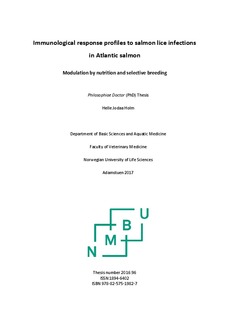| dc.contributor.advisor | Evensen, Øystein | |
| dc.contributor.author | Jodaa Holm, Helle | |
| dc.date.accessioned | 2017-07-04T15:30:57Z | |
| dc.date.available | 2017-07-04T15:30:57Z | |
| dc.date.issued | 2016 | |
| dc.identifier.issn | 1894-6402 | |
| dc.identifier.uri | http://hdl.handle.net/11250/2447806 | |
| dc.description.abstract | Infections with the salmon louse Lepeophtheirus salmonis (L. salmonis) represent one of the most important limitations to sustainable Atlantic salmon (Salmo salar) farming today. The
parasite exerts negative impacts on health, growth and welfare of farmed fish, and there are concerns of the impact on wild salmon populations. Current control relies heavily on the use of a few chemical in-feed or bath treatments and an increasing number of reports states their reduced efficiency. Increased mortalities during treatments are also frequently reported. The narrow treatment repertoire is also a consequence of the difficulty in developing novel anti-parasitic chemical treatments that are efficient against lice, environment-friendly and posing no risk for the consumers. Functional feeds and selective breeding are considered two promising alternative approaches for management of salmon lice infections, and understanding the molecular basis of protection against lice is expected to help in their successful application in Atlantic salmon aquaculture. | nb_NO |
| dc.description.abstract | Infeksjoner med lakselus (Lepeophtheirus salmonis) er en av de største utfordringene i dagens oppdrettsnæring, spesielt relatert til påvirkningen på dyrevelferd, resistensutvikling av de antiparasittære midlene brukt, økt infeksjonstrykk på villfisk, redusert vekst og slaktekvalitet. I dag kontrolleres lusenivået i all hovedsak ved hjelp av medisiner, som kan medføre økt mortalitet i seg selv. Behandlingsalternativene er begrenset, fordi det er vanskelig å utvikle nye medisiner mot lus som er både effektive, miljøvennlige og trygge for konsumentene. Behovet for å finne alternative strategier for å håndtere lakselusproblemet for fremtiden er stort, der både funksjonelle fôr og selektiv avl regnes som lovende alternativer. Dette krever en god forståelse av de molekylære responsmekanismene hos atlantisk laks ved lakselusinfeksjoner. | nb_NO |
| dc.language.iso | eng | nb_NO |
| dc.publisher | Norwegian University of Life Sciences, Ås | nb_NO |
| dc.rights | Attribution-NonCommercial-NoDerivatives 4.0 Internasjonal | * |
| dc.rights.uri | http://creativecommons.org/licenses/by-nc-nd/4.0/deed.no | * |
| dc.subject | Lepeophtheirus salmonis | nb_NO |
| dc.subject | Atlantisk laks | nb_NO |
| dc.subject | Lakselus | nb_NO |
| dc.subject | Selektiv avl | nb_NO |
| dc.subject | Glucosinolates | nb_NO |
| dc.subject | Isothiocyanates | nb_NO |
| dc.subject | Functional feeds | nb_NO |
| dc.title | Immunological response profiles to salmon lice infections in Atlantic salmon : modulation by nutrition and selective breeding | nb_NO |
| dc.type | Doctoral thesis | nb_NO |
| dc.subject.nsi | 900 | nb_NO |
| dc.subject.nsi | 400 | nb_NO |
| dc.subject.nsi | 700 | nb_NO |
| dc.relation.project | Research Council of Norway, SFI-Sea Lice Research Centre, grant number 20351. | nb_NO |

